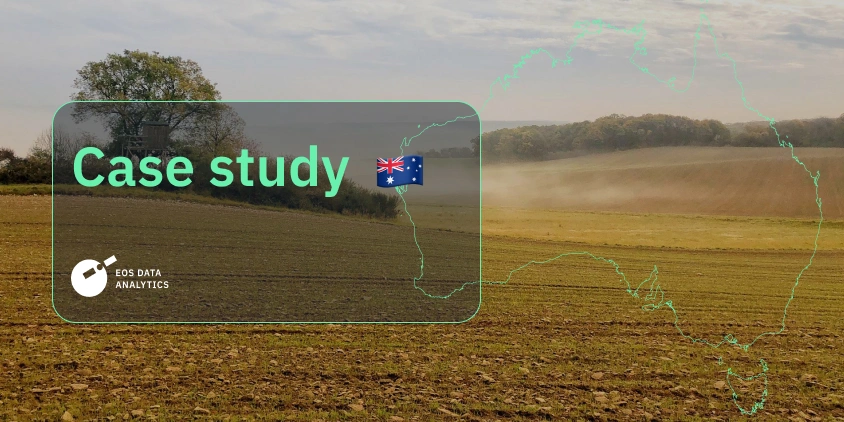
Richard Stone Uses EOSDA Crop Monitoring For Carbon Reports
Meet Richard Stone, a soil nutrition and health consultant with more than two decades of experience. Over the past two decades, Richard’s main interest and work has been concentrated on reducing granular inputs of soil-applied fertilizer, in particular nitrogen, by 20% and replacing them with foliar-applied fertilizers, a process known as “Integrated Fertilizer Management” (IFM). IFM is all about feeding the plant via the three pathways plants use to obtain nutrients, namely via the seed, soil, and leaf.
However, Richard is faced with the dilemma of measuring the fertilizer effects. He needs to gather and save vast amounts of data so that, later, he can add them to the report for the Clean Energy Regulator. Such reports must be submitted regularly and require frequent on-field measurements, forcing Richard to drive to the client’s location for several hours. Some things are easier to check online than make that long trip every single time. Here is where EOSDA Crop Monitoring came in handy. This platform assists Richard with saving all the data connected to his field, including the state of vegetation linked to photosynthesis levels, dates of fertilizer spraying, and GPS spots where he typically samples the soil for analysis. EOSDA Crop Monitoring broadens Richard’s abilities to manage projects in so many ways. Read on to find out how.
| Challenge | Richard Stone needed to assess the effectiveness of the new fertilizer treatment on the carbon sequestration levels in the soil on the field that is a five-hour drive from his home. |
| Solution | He used EOSDA Crop Monitoring features, like vegetation indices, to calculate the field’s greenness and Weather to know when to apply inputs. Richard also used the Scouting and Activity Log features to track his activities and field visits. |
| Outcome | Richard now saves time for frequent field visits. All of the needed information is securely stored in EOSDA Crop Monitoring, and he uses the insights for carbon sequestration reporting. |
Overview: About Richard Stone
Richard Stone is an agricultural consultant with 25 years of experience in cost-effective crop growth. He works with Australian farmers and agribusinesses, helping them understand their plants and soil health and improve nutritional tactics. Richard performs soil and leaf tissue tests plus visual appraisal to identify plant stress and nutrient disorders. He is an expert on applying seed nutrient primers and foliar nutrients to increase plant efficiency and yield. As Australian dryland cropping is the largest exporter of agricultural production, Richard works on expanding the manufacture of broadacre crops .
Challenge: Data Recording Capabilities And Frequent Field Visits
In 2022, Richard directed his attention to carbon sequestration as a new way of taking care of the soil. As the plants grow, they capture carbon dioxide from the atmosphere and energy from light through their leaves via photosynthesis. The captured carbon then converts into proteins, amino acids, and sugar, which then travel to the roots and feed the microbes and fungi in the rhizosphere. Agrarians are looking into ways to capture more carbon from the atmosphere and then monetize that by receiving carbon credits. As part of Richard’s consultancy service, he is helping his clients apply and register their projects for the carbon credits program with the Clean Energy Regulator (CER) .
This organization has developed legislation to make the economy more environmentally sustainable by introducing methods that will reduce emissions. One of the projects registered to help with this mission involves collaborating with agribusinesses to find new ways of sequestering carbon. In 2022, one of Richard’s clients, who owns an irrigation farm in Hillston, New South Wales, Australia, expressed interest in registering a project to improve soil health and yield and earn carbon credits.
Eligibility for carbon credits will be activated when it is proven that the new methodology (IFM) has increased soil organic carbon. Carbon credits can either be sold for monetary gain or withheld by the initiator to become a carbon-neutral business. Richard needs to measure the effects of the fertilizer on the pilot field to the Australian Clean Energy Regulator (CER) and help make his client eligible to earn so-called carbon credits, namely, the money because this fertilizing method helps to bring more carbon from the atmosphere to the ground and slow down climate change.
The process of registering a project for carbon credits (Australian Carbon Credit Units (ACCUs) with the CER is a complicated procedure, requiring a lot of details and data to be recorded. To become a registered project with the CER, one has to undertake a new methodology that has not been used on the farm before. In the case of the Hillston Project, the strategy is to combine the use of RLF seed nutrient primers and foliar fertilizers to reduce granular soil-applied fertilizers by at least 20%. Using those advanced nutritional products helps to build root systems and provide vital macro and micronutrients to the plant via the seed and leaf. The weather in Australia can be unpredictable, with drought and waterlogging stress being common. RLF products are helpful in providing plants with nutrients when they are unavailable from the soil. Bearing these factors in mind, using RLF methodology has the ability to increase yield and biomass, which is a crucial point in building soil organic carbon and earning ACCUs.
Finally, after 9 months, the project was accepted. The pilot field they chose for the program is a 46-hectare center-pivot field, a five-hour drive from Richard’s hometown. The challenge with this whole endeavor is that the CER requires reporting and auditing procedures, and the amount of data needed is quite substantial. Richard needs to assess the vegetation levels and ensure that seed nutrient priming, soil sampling results, and timely foliar-applied fertilizers are applied regularly and effectively. Those two needs can be covered by remote sensing technology, on which EOSDA Crop Monitoring is based.
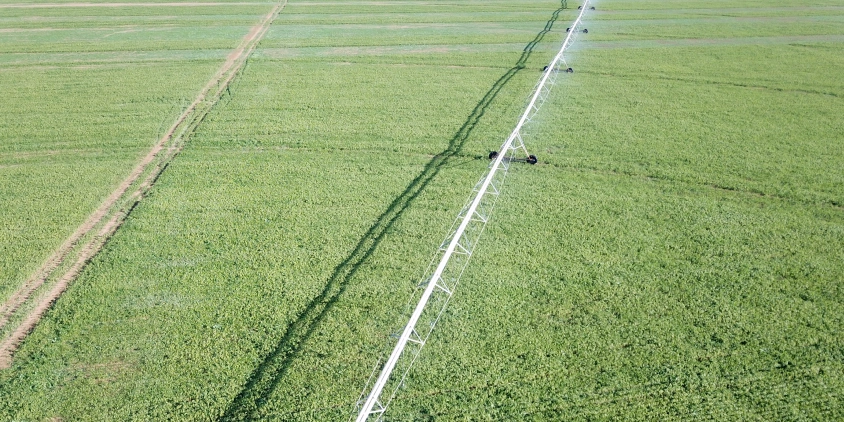
EOSDA Crop Monitoring
Using satellite monitoring for remote fields management in one platform!
Solution: Remote Evaluation Of Foliar Fertilizer Efficiency
Richard first started using EOSDA Crop Monitoring in 2022 as a means to alleviate the amount of traveling he was doing to service his clients. Sometimes, projects could be up to 500–700 kilometers from his home. Satellite data analytics helps paint a comprehensive picture of what the field in question looks like without the need to drive back and forth to a location constantly. For Richard, this is a relief. Though he still needs to visit the field to evaluate carbon levels, with EOSDA Crop Monitoring, he can reduce the number of trips to assess the vegetation levels of crops.
For that, Richard uses NDVI (Normalized Difference Vegetation Index), which is updated every five days on the platform. The index shows how the vegetation level changes over time so that when another round of fertilizer is applied, Richard knows its effects, and the platform keeps all the records.
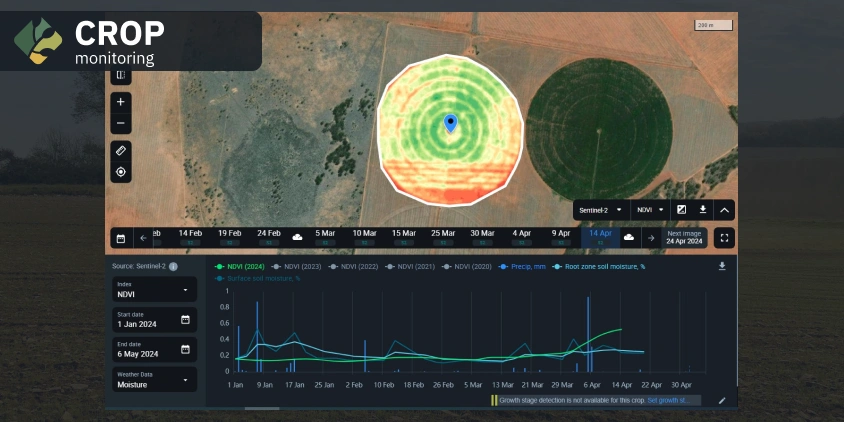
He also uses the NDWI (moisture index) and Weather function to identify the best time to apply the new methodology to consider weather and plant growth stages. It is crucial not to miss a rainy day so that it won’t wash all the fertilizer away, and with the long-distance rides, it is most convenient that Richard can plan those trips ahead of time. All the activities on the field can be recorded in the Activity Log part of the platform, where Richard can add past field actions and plan future ones. This not only allows for order in his business but also can be used to create a comprehensive report when it is time to communicate the results of their experiment to the CER.
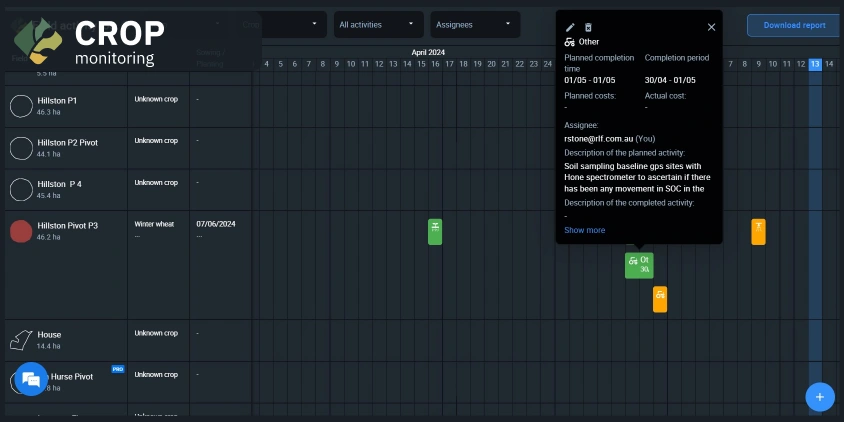
Every field visit can also be recorded and stored within the Scouting functionality with appropriate pictures and notes. Richard uses it to add information when he evaluates the carbon levels in the ground. He visits 25 spots every time. To keep track of any changes in SOC, Richard measures the indicators with a Hone soil carbon spectrometer . Although this equipment is not yet recognized by the CER for baseline testing, it is a valuable addition for plotting changes in SOC, serving as a checkpoint device.
Using an IFM approach to plant nutrition involves treating the seed with phosphorus and trace elements to increase seed nutrient levels, which are often low in Australian seeds. Critical analysis of soil tests is important so that any deficiencies and excessive nutrient levels can be counteracted using foliar fertilizers.
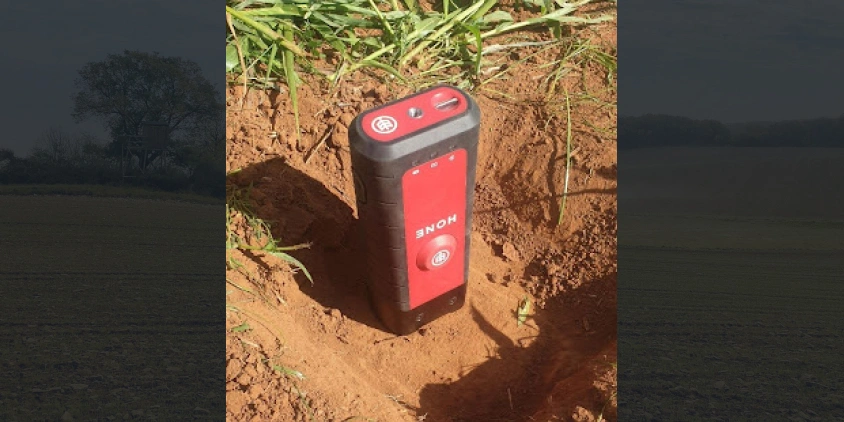
The pilot field is not only processed with a fertilizer. Richard and his team have completed a number of soil restoration techniques to ensure carbon sequestration and the pilot project’s success, including the addition of lime and cover crops. They planted canola in 2023, followed by cover crops in March 2024, namely, millet and vetch, to increase nitrogen and carbon in the soil as well as provide a ready source of nutrients for the resident biological life, namely, microorganisms. The millet and vetch will be turned back into the soil as green manure at the end of May 2024 before planting winter wheat in early June. All data, securely stored in EOSDA Crop Monitoring, will be a part of a comprehensive report at the end of the project.
EOSDA Crop Monitoring serves as an irreplaceable helper in Richard’s line of work. It allows him to store vast amounts of data, rely on analytics rather than manual calculations, and plan for the future to develop and scale this methodology.
According to the time of year in Australian cropping, the ground is bare and does not offer much opportunity for satellite imagery. However, when the crop is growing, such add-ons can predict moisture, temperature, and forecasting. I can see a great future for using EOSDA Crop Monitoring to include in my portfolio of tools. It helps to increase my and my client’s knowledge of what is happening to the crop and allows for counteractive action, mainly by using more advanced nutritional practices. For example, foliar fertilizers supply nutrients to plants when they cannot access them from the soil due to a dry period or waterlogging.
Outcome: Carbon Credits For Australian Farmers
Currently, Australian farmers and agribusinesses hesitate to apply for the CER carbon credits program. Farmers need to register the project and comply with a 25-year contract to increase SOC. Numerous measurements and reporting must be undertaken, which is not a decision one can take lightlyю During that time, more audits and reporting must occur, which also repulses some farmers. However, their conventional broadacre farming practices are no longer sustainable in a world where climate change demands better land care.
Sustainable farming that helps to nourish the soil and mitigate climate change is the new way of thinking that Richard and his client are adopting. Their foliar fertilizer project is one of the many ways to promote carbon sequestration and put Australia on the path of greener agriculture. By utilizing advanced tech solutions like EOSDA Crop Monitoring, Richard Stone can expand his services by helping his clients adopt sustainable practices and profit from increasing SOC and the added financial benefit. Step by step, he is changing the world for the better.
About the author:
Kseniia Kunakh has over 6 years of writing experience, working in various domains, including business, educational, and media-directed texts. Kseniia’s previous experiences as a development manager in a Ukrainian eco-NGO and as a talent matcher in an IT company make her a perfect combination of someone who is passionate about eco-tech innovations and can communicate about them with ease.
Recent articles

Analyze 2025 & Plan Your Best Year Yet: LandViewer Christmas Offer
It’s the most wonderful time of the year! The Christmas holidays are here, and so is your chance to analyze 2025 and plan a prosperous 2026 with more affordable Pro plans in LandViewer.

EOSDA Models Climate Change Impact On Sugarcane Yields
EOSDA modeled future temperature, rainfall, and other climate impacts on Veracruz sugarcane. The results help growers plan long-term adaptation strategies, including timing, varieties, and irrigation.

EOSDA LandViewer Black Friday Sale: Exclusive Offers & Giveaway
This Black Friday, LandViewer offers new users the chance to save on monthly plans, get extra months with yearly subscriptions, and participate in a free annual plan giveaway.